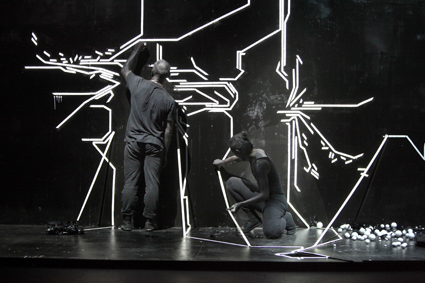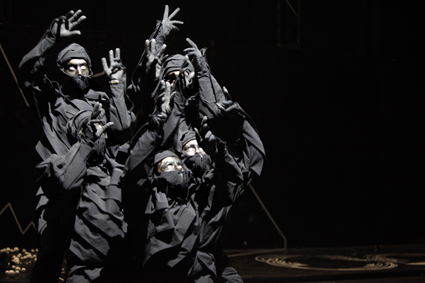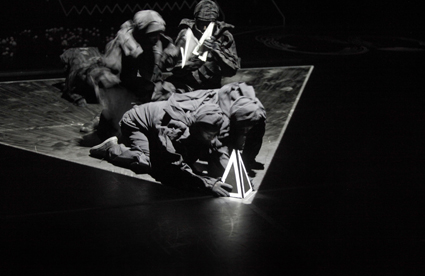dance massive 2013
March 27 2013
dance: installed, immersed, hybridised
keith gallasch: dance massive 2013
quotidian moves, gangnam-style
philipa rothfield: ben speth, wetubelive
dance massive 2013
sounds to dance to, with, against
gail priest: sound design in dance massive 2013
March 26 2013
the life in the work
philipa rothfield: tracie mitchell, dance screen retrospective
youtubing live
varia karipoff: ben speth, wetubelive
dance massive 2013
March 24 2013
dance & disorientation
keith gallasch: tim darbyshire, more or less concrete
more or less monstrous
jana perkovic: atlanta eke, monster body
realtime tv: tim darbyshire, more of less concrete, dance massive 2013
March 22 2013
ritual entwining
philipa rothfield: soo yeun you, [gu:t] [work-in-progress]
strange affliction: dance massive & transcendence
keith gallasch: jo lloyd, future perfect
March 21 2013
a not so private hearing
carl nilsson-polias: tim darbyshire, more or less concrete
realtime tv: antony hamilton, black projects 1& 2, dance massive 2013
something ends, something begins
virginia baxter: dance exchange, dance for the time being - southern exposure
dance massive 2013
the perfection of submission
varia karipoff: jo lloyd, future perfect
March 20 2013
inner fury, seductive skill
philipa rothfield: anouk van dijk, chunky move, 247 days
March 20 2013
old tropes & the new disconnect
carl nilsson-polias: lucy guerin inc & belvoir, conversation piece
March 19 2013
now, then, now
keith gallasch: sandra parker, the recording
realtime tv: anouk van dijk, 247 days, chunky move, dance massive 2013
dance massive 2013
March 18 2013
creating an affective community
jana perkovic: matthew day, intermission
fun and the damage done
keith gallasch: larissa mcgowan, skeleton
more than smoke and mirrors
virginia baxter: ashley dyer, life support
realtime tv: lee serle, p.o.v., dance massive 2013
March 17 2013
realtime tv: dalisa pigram, gudirr gudirr, dance massive 2013
the body un-mirrored
jana perkovic: anouk van dijk, chunky move, 247 days
the origins of feeling
philipa rothfield: sandra parker, the recording
March 16 2013
realtime tv: stephanie lake, dual, dance massive 2013
dance massive 2013
March 15 2013
a dance for dark times
virginia baxter: dalisa pigram, gudirr gudirr
brittle bones & internal electricity
carl nilsson-polias: larissa mcgowan, skeleton
in the thick of it
philipa rothfield: lee serle, p.o.v.
March 15 2013
inside the audience
jana perkovic: lee serle, p.o.v
the poetry of pain
keith gallasch: stephanie lake, dual
dance massive 2013
when two become one
varia karipoff: stephanie lake, dual
March 14 2013
blacker than black
keith gallasch: antony hamilton, black projects 1 & 2
life in a puff
carl nilsson-polias: ashley dyer, life support
March 13 2013
dark symmetries
carl nilsson-polias: antony hamilton, black projects 1 & 2
lines of flight
philipa rothfield: dalisa pigram, gudirr gudirr
dance massive 2013
suggestive formalism
jana perkovic: natalie abbott, physical fractals
unsettling the audience
varia karipoff: natalie abbott, physical fractals
February 22 2013
an intense manifestation of dance
philipa rothfield: dance massive 2013, melbourne
dance massive 2013: from the archive
lucy guerin inc, conversation piece; antony hamilton, black project; atlanta eke, this monster body; matthew day, intermission; jo lloyd, future perfect; tim darbyshire, more or less concrete; natalie abbot, physical fractals; ben speth, wetubelive
 |
Antony Hamilton, Melanie Lane, Black Project 1
photo Ponch Hawkes |
BACK IN 2008, ANTONY HAMILTON’S DEBUT FULL-LENGTH WORK, BLAZEBLUE ONELINE (
RT85), ESTABLISHED SOME OF HIS CHOREOGRAPHIC REFERENCE POINTS: STREET DANCE, GRAFFITI, THE LINK BETWEEN THE VISUAL AND THE PHYSICAL.
In that production, the sheer bursting mass of his creative energy led to a procession of set pieces both tonally and chromatically varied. Given a large blank canvas, Hamilton threw everything on it at once. Somehow, it hung together remarkably well.
If Blazeblue Oneline was Hamilton’s thesis, then Black Projects 1 & 2 are his antithesis. Each is fascinated with the physical possibilities of mark-making and the ways in which a flat canvas can achieve three dimensions. However, where the former is ranging, the latter is taut. Where the former is exuberant, the latter is stern. Light, dark. Colourful, monochromatic. Et cetera. Hamilton has zeroed in on one section of his palette in order to go deeper rather than broader.
Black Project 1 is a study on the most minimal of variations. At first, there is nothing but a rumble. The rumble itself, if magnified, if expanded, would be discernible as a set of beats or individuated vibrations. But here it is a single sound, as large and enveloping as the sky. The set is a black wall built on top of a black floor in front of a black curtain. But none of the blacks is truly black; there is a bit more gloss here, a small scuff there. The tonal vagaries are enhanced by a subtly shifting, cloudy projection on the wall.
In his program note, Hamilton claims he set out to investigate whether it is possible to create a controlled, neutralised aesthetic environment devoid of the subjectivity of context. He readily admits he failed. However, subjectivity aside, the kind of minimalist order he seeks will always be trumped by instabilities—entropy inevitably wins. One can look to minimalist music for precedents: Charlemagne Palestine’s Strumming Music, in which two notes on a piano are played continuously for some fifty minutes until the harmonics and tuning change entirely; or the phasing of Steve Reich’s tape loops. Given time and space, imperceptible differences become meaningful.
Hamilton’s choreography retains an austere, antihumanist formalism throughout Black Project 1. It resists any ready kind of psychological meaning making. Perhaps its only consistent symbolism comes in the paradoxical theme of erasure as revelation. The two dancers remove tape from their blackened bodies to reveal white skin, they remove tape from the walls to reveal jagged lines that are half silicone chip, half Suprematist painting. There is the potential for a political statement here, but Hamilton is too clear-eyed to step fully into any easy narrative. He remains steadfast in his investigation of tone and neutrality.
 |
Black Project 2, Antony Hamilton
photo Ponch Hawkes |
In Black Project 2, the visual language is even more restricted than in Black Project 1, though the number of dancers has tripled to six. The floor projections are almost exclusively of triangles, the costumes are identical baggy black body suits, the choreography largely limited to pivoting symmetrically about a central axis (though the dancers’ symmetry unfortunately falters in more complex choreographic phrases).
The central axis is key. The dancers slink on in front of the set of Black Project 1 and mass in a huddle. As the dominating sound design shifts from rasping solidity into fluidity, so the dancers transpose themselves into a six-headed beast, symmetrical on either side of the centre line. As they move their arms, they become a giant, animated, breathing Rorschach test. Neutrality be damned, Hamilton challenges us to project our Freudian unconscious onto the bodies of these dancers. Is this a rebuke to subjectivity? A literalising of the symbolic? Or is the reference accidental?
 |
Black Project 2, Antony Hamilton
photo Ponch Hawkes |
Black Project 2 feels less assured than the first; its connection between form and content is less coherent. The symmetry of the choreography could easily be read as a kaleidoscopic expression of fractal geometry, the projections certainly point that way. But with this colder reading of intent, how do we make sense of the moments that are not symmetrical? When one dancer falls deliberately out of line, the others quickly draw them back in. Is this a nod to the human desire for breaking machine-like rules or is it a barbed attack on the normative functions of Freudian psychotherapy? Probably neither. Rather than eschewing symbolism, here, Hamilton piles it on with a confounding thickness.
However, at the end of Black Project 2, Hamilton’s symbolism pays dividends. The six dancers reverently construct a small black pyramid to idolise. Then, in the closing moments, the pyramid vertices glow red—the only colour yet seen. While the dancers remain bowed in shadow, in the audience we find ourselves applauding a glowing red pyramid as though it really were a thing worth idolising.
Dance Massive: Arts House and Antony Hamilton Projects, Black Projects 1 & 2, choreography, concept Antony Hamilton, Black Project 1: performers Antony Hamilton, Melanie Lane, video projection Olaf Meyers, music Robert Henke, Mika Vainio and Vainio and Fennesz, design Antony Hamilton; Black Project 2: performers James Batchelor, Jake Kuzma, Talitha Maslin, Jessie Oshodi, Marnie Palomares, Jess Wong, costume design Paula Levis, sound designer Alisdair Macindoe, video design Kit Webster, set construction, production Management Matthew Scott, Megafun, producer Freya Waterson, Insite Arts; Arts House, Meat Market, Melbourne, March 12-16; http://dancemassive.com.au/
© Carl Nilsson-Polias; for permission to reproduce apply to [email protected]
Back to top











 back
back